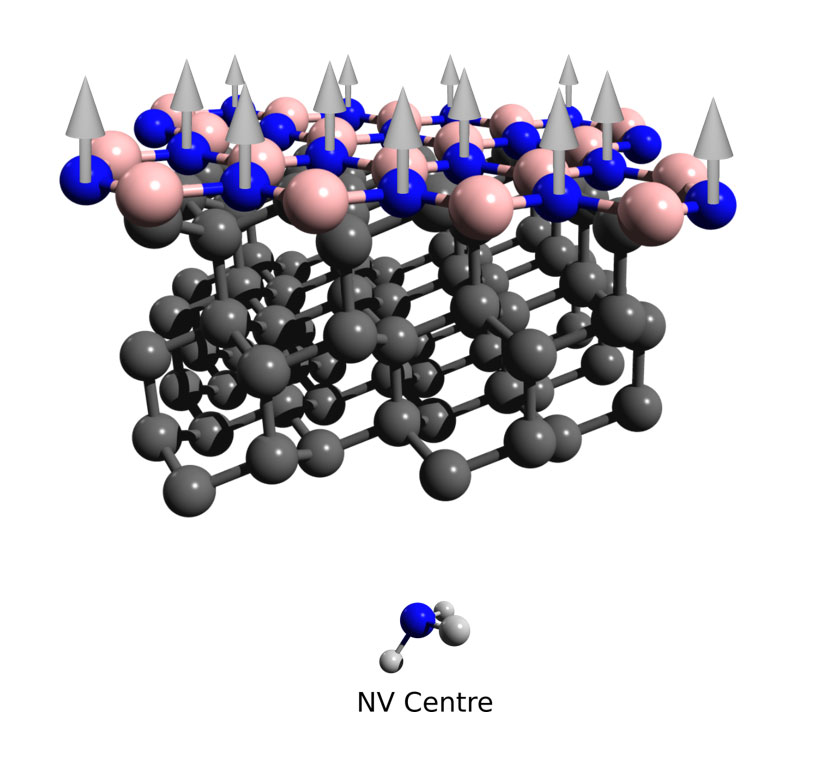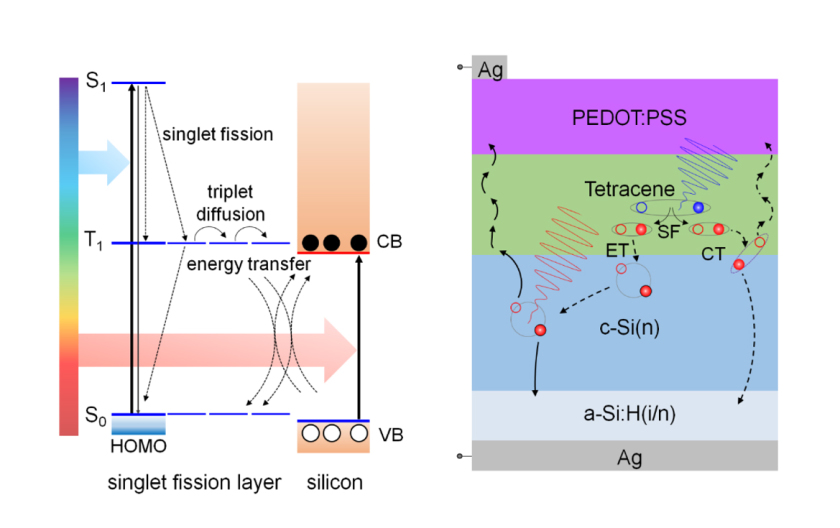Department Spins in Energy Conversion and Quantum Information Science
Working Groups
Quantum Information with Solid State Spins - QuISS
Group leader: B. Naydenov
The research group "Quantum Information with Solid State Spins" (AG QuISS) is dedicated to the investigation of quantum materials that are crucial for the development of a quantum computer. The working group focuses on spin-based qubits. Such systems offer the possibility to design their quantum mechanical states with .atomic precision, so that the concepts of entanglement, coherent control and quantum measurement can be freely explored and used.
As a prominent example, the nuclear spin in a two-dimensional layer (for example in fluorographene, see figure) have long coherence times and a very large Hilbert space and could be the building block of a solid state quantum simulator. Their use as protected quantum registers, which can also be quickly manipulated and read out by means of magnetic resonance (NMR, EPR), has been demonstrated. For the readout process, AG QuISS concentrates on spin color centres (NV centre in diamond), which offer scalability and integration capability. With this unique physical system, quantum states at interfaces between diamond and nuclear spin-bearing molecules are investigated. Within the EPRoC project, the AG QuISS is in the process of putting an NV-based AFM into operation, which will allow magneto spectrometry with nanoscale resolution and high sensitivity.
Spins in Energy Materials - SPEM
Group leader: B. Naydenov
The working group Spins in Energy Materials (AG SPEM) focuses on the identification and quantification of paramagnetic states in energy materials. The EPR activities take place in two Joint Labs, the Berlin Joint EPR Laboratory (BeJEL) between HZB and FU Berlin (including transient EPR, in cooperation with JunProf J. Behrends) and the Joint Lab EPR4Energy between MPI-CEC and HZB in cooperation with Dr. Alexander Schnegg (including frequency-domain THz-EPR).
The JointLabs (location Adlershof) are equipped with five unique EPR spectrometers, covering a frequency range from 9 GHz to more than 20 THz and magnetic fields up to 12 T. In addition, a 400MHz NMR laboratory was established in March 2020. THz-EPR at BESSY II and NMR are operated as user facilities at HZB.
The EPR activities take place in two Joint Labs, the Berlin Joint EPR Laboratory (BeJEL) between HZB and FU Berlin (including transient EPR, in cooperation with JunProf J. Behrends) and the Joint Lab EPR4Energy between MPI-CECand HZB in cooperation with Dr. Alexander Schnegg (including frequency-domain THz-EPR).
One focus of the research of the SPEM group is the development and application of new operando/in situ EPR methods, such as in-situ (photo)catalysis (cooperation MPI-CEC) or EPR-on-a-Chip (EPRoC), which is developed together with the University of Stuttgart. Besides the investigation of structural and electrical defects in solar cell materials, the aim is to study structure-function relationships at catalytically active interfaces as well as in electrochemical processes as occur in battery materials. The EPRoC and NMR activities have been funded by the BMBF since May 2019 with 6.6 M€ through a network coordinated by the head of ASPIN, with the long-term goal of commercialization. The research of the SPEM group focuses on the development and application of operando/in situ EPR methods for (photo)catalytic, electrochemical and solar cell applications as well as on the investigation of charge transfer processes at heterointerfaces using electrically detected magnetic resonance (EDMR) and conductive AFM (cAFM), the latter in close cooperation with the University of Utah (USA).
Spectral Conversion Systems - SPECS
Group leader: R. MacQueen
The working group Spectral Conversion Systems (AG SPECS) conducts fundamental and applied investigations of organic spectral conversion materials. Organic spectral conversion materials have the capacity to undergo exciton fission and fusion, which entails the spontaneous splitting or merging of quanta of electronic energy. This unusual property is sensitive to the molecular electronic structure, as well as the intermolecular packing. Our primary interest is to employ organic spectral converters to effectively alter the energy distribution of light impinging on a semiconductor. This spectral reshaping can substantially improve the efficiency with which quantum solar energy converters change the energy of sunlight into electrical or chemical energy. In particular, harnessing spectral conversion is a promising method by which the Shockley-Queisser single junction efficiency limit may be overcome.
The AG SPECS pursues two goals:
- Exploiting downconversion via singlet fission (SF) in silicon solar cells, in which two excitons are generated via one photon, which can then be separated at a hybrid interface (e.g. silicon/tetracene).
- Exploiting upconversion, in which two low-energy triplet excitons optically excited in a layer of organic spectral conversion molecules fuse via triplet triplet annihilation (TTA) into a highly excited singlet state, which then emits a high-energy photon that can be captured in a high bandgap absorber.
For SF, the functional silicon-organic interface is a critical component. An important goal is to understand this interface by combining computational chemistry, EPR, microscopy, fluorescence spectroscopy, pump-probe and X-ray spectroscopy (XPS, UPS, HAXPES) and to optimize it for efficient charge separation. Very promising experiments with quantum yields of almost 150% at silicon interfaces have recently been achieved.
It is expected that the SF project will provide detailed insights into new hybrid silicon heterointerfaces for power generation by spectral conversion and will define a new thematic direction for future silicon devices that may exceed the Shockley-Queisser limit. This work is currently anchored via a milestone in POF III, which is to be significantly expanded in POF IV in cooperation with KIT and NW Nanosippe at HZB.
Typical photon upconverters are based on organometallic complexes whose upconversion yield under single-sun excitation is unfortunately still too low. In the upconversion project, the single-sun output of upconverters is to be significantly improved by replacing molecular sensitizers with thin hybrid perovskite films. This creates a so-called energy funnel, which can then be applied to metal oxide photoanodes with a large bandgap and lead to more efficient solar water splitting. It is expected that the project will provide technology-oriented insights into charging and energy transfer processes at hybrid perovskite interfaces.
The working group connects closely to the departmental theme of electron spins via the triplet exciton, which is a spin-1 quasiparticle. Triplet excitons are the key intermediate electronic state in singlet fission and triplet fusion processes, and monitoring the formation, diffusion and consumption of triplets is a key component of our research activity.
The work of the SPECS group is highly interdisciplinary and includes interface design and implementation in devices (in cooperation with AG Microscopy, PVcomB, EE-IS, EE-IF, NWG of HZB), pump-probe spectroscopy, (photo)electrical measurements, EPR, surface characterization and structural investigations by microscopy (cooperation AG SPEM and QuISS, EE-NSIP, EE-ISF). Furthermore, the group uses electrical and optical simulations (the latter in cooperation with EE-NSIP) to determine the physical limits of spectral conversion. Molecular synthesis is performed in collaboration with research groups in the US and Czech Republic, and DFT simulations are performed by the research group of Dr. Gerstmann (University of Paderborn). The working group collaborates with research groups in Germany, the UK, Netherlands, Czech Republic, USA, and Australia.


